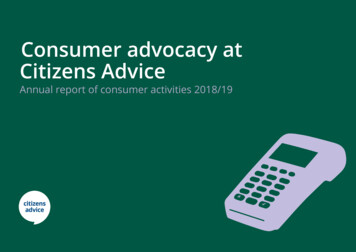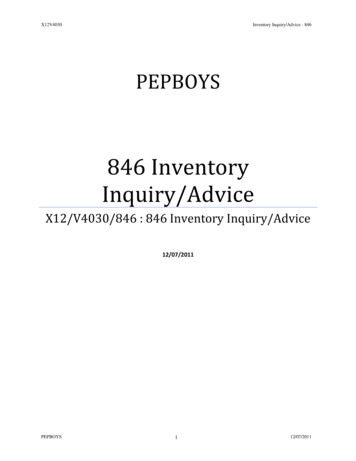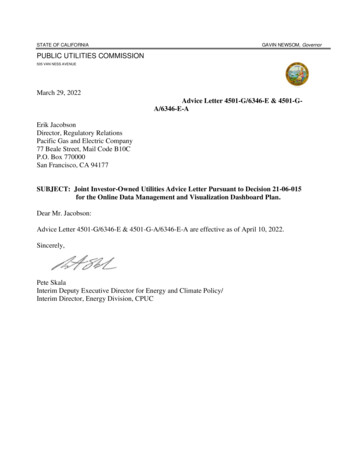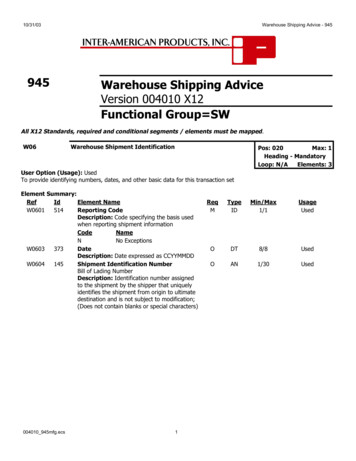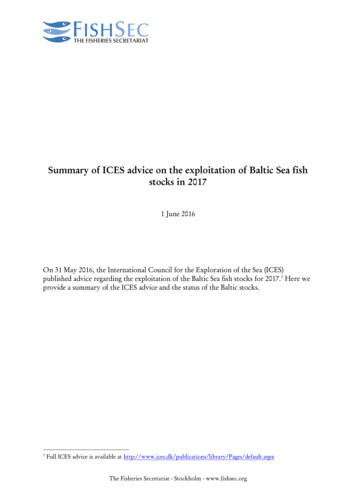
Transcription
Summary of ICES advice on the exploitation of Baltic Sea fishstocks in 20171 June 2016On 31 May 2016, the International Council for the Exploration of the Sea (ICES)published advice regarding the exploitation of the Baltic Sea fish stocks for 2017.1 Here weprovide a summary of the ICES advice and the status of the Baltic stocks.1Full ICES advice is available at ult.aspxThe Fisheries Secretariat - Stockholm - www.fishsec.org
–2–CONTENTSSUMMARY TABLE . 3INTRODUCTION . 4Total catch, total commercial catch and Total Allowable Catch (TAC) . 4Definitions and Basis of ICES advice. 5Precaution and the MSY approach . 6What happens next? . 7DETAILED SUMMARY OF ICES ADVICE. 8CODSubdivisions 22–24, Western Baltic . 9Subdivisions 25–32, Eastern Baltic. 10HERRINGSubdivisions 20-24, Western Baltic Spring Spawners . 12Subdivisions 25–29 & 32, Central Baltic Sea, excluding Gulf of Riga . 12Subdivision 28.1, Gulf of Riga. 13Subdivision 30, Bothnian Sea . 13Subdivision 31, Bothnian Bay. 14SPRATSprat, Baltic Subdivisions 22-32 . 15SALMONSalmon in the Baltic Sea . 16Subdivisions 22–31, Baltic Sea excluding Gulf of Finland . 17Subdivision 32, Gulf of Finland . 18SEA TROUTSea trout. 19FLATFISHESFlatfishes in the Baltic Sea . 20Plaice . 20Turbot . 21Dab . 21Brill. 21Flounder . 21The Fisheries Secretariat - Stockholm - www.fishsec.org
–3–SUMMARY TABLETable showing ICES advice for 2017 including the total commercial catch in tonnes, percentagedifference from advice for 2016, and the 2017 EU quota corresponding to ICES adviceStock by management area,subdivisionCod, Western Baltic, 22-24-55%*917Cod, Eastern Baltic, 25-3226 994-8%25 644 Herring, Western Baltic SpringSpawners, 20-2456 8028%28 401**216 0007%182 549*** Herring, Gulf of Riga, 28.123 078-12%27 429***Herring, Bothnian Sea, 30134 55639%Herring, Bothnian Bay, 316 442-3%314 00053%Plaice, Kattegat, Belts & Sound, 21238 333-4%Plaice, Baltic, 24-322 58720%116 0000%89 320 11 8000%9 558 00%Brill, Baltic, 22-3218-22%Dab, Baltic, 22-323 0693%Flounder, Belt Sea & Sound, 22-233 65020%34 69020%2 527-3%32920%194-2%Sprat, Baltic, 22-32Salmon, Baltic, 22-31 (count of fish)Salmon, Gulf of Finland, 32 (count ofreared fish)Sea trout, Baltic, 22-32Flounder, Southern Baltic, 24-25Flounder, Eastern Gotland & Gulfof Gdansk, 26 & 28Flounder, Northern Baltic, 27 & 2932 (landings)Turbot, Baltic, 22-32 (landings)****** % Changefrom ICESadvice for 20162017 EUcommercialquotacorresponding toICES advice,adjusted formanagementareas and reducedby third countryquotas917 (3 475)*Herring, Central Baltic, 25-29 & 32 Advised totalcommercialcatch (t) for2017, acrossthe stock’sfull range &includingthird countrycatch140 998 273 000 7 861 Not quotamanagedBrackets include total catch (commercial recreational), and advice comparison is with this #Reflects TAC splitting procedure in negotiated agreement for Baltic catch (SD 22-24)Adjusted for the relative quota shares of each stock caught in the adjacent management areaPreliminary estimate based on 2016 Russian quota or prior TAC sharing arrangementBothnian Bay & Bothnian Sea herring are managed under one TACEstimated plaice catch in the Kattegat (SD 21) is deducted to determine the Baltic area quotaAfter removing unreported, misreported, and discarded catchThe Fisheries Secretariat - Stockholm - www.fishsec.org
–4–INTRODUCTIONICES provides scientific advice to clients within the context of international agreements onfisheries, conservation, and sustainable development. Within this framework ICESresponds to policy needs such as regular EU requests for advice related to the goals of theCommon Fisheries Policy (CFP), including Maximum Sustainable Yield (MSY).2Total catch, total commercial catch and Total Allowable Catch (TAC)Readers of ICES advice must understand that “total catch” and “total commercial catch”are not always synonymous with Total Allowable Catch (TAC).ICES advises the total commercial catch for a stock whenever possible. Total catchrepresents the total fishing mortality for a stock from all stakeholders and across thestock’s full range, possibly across multiple management areas. Total commercial catch isfishing mortality only from commercial fishing.For fisheries under the landing obligation, the corresponding TAC (or EU quota, if theTAC reflects third country catches) represents total commercial catch. For fisheries notyet under the landing obligation, the corresponding TAC represents only commerciallandings. As of 1 January 2017, all catches of plaice in the Baltic will fall under the landingobligation in addition to herring, sprat, salmon, and cod.3Differences between ICES total catch and regulatory TAC or quotatotal catchTotal Allowable Catch (TAC), or quotaFrameworkscientificmanagement, informed by scienceConstraintstock rangemanagement areaStakeholderallcommercialFishing Mortalitytotaldependent on landing obligationICES may highlight distribution issues related to stock mixing, interspecies relationships,or management area mismatches, but holds no preference for any distribution methodexcepting those which could exceed the advised total catch. For example, stock mixingbetween the Baltic cod stocks in subdivision (SD) 24. Readers must examine ICES adviceclosely and be familiar with the management of a relevant stock to determine what portionof the advised total catch represents the advised TAC.23Council Regulation (EU) 1380/2013Commission Delegated Regulation (EU) 1396/2014The Fisheries Secretariat - Stockholm - www.fishsec.org
–5–Definitions and Basis of ICES adviceMSY, at its core, is a fisheries exploitation concept which seeks the largest long-term stablecatch possible. Global use and interpretation of the MSY approach has evolved incomplexity since the early 20th century but the concept remains the same: an overfishedpopulation is unable to support MSY.The current EU policy interpretation of MSY uses the surplus production concept. Thisassumes that from an abundant fish population in a stable environment, fisheries cansustain a maximum stable and predictable catch. This is the foundation of the MSYapproach which Europe adopted in 2013 in the reformed CFP, and that ICES hasdeveloped into its own MSY approach when providing advice on fishing opportunities.MSY estimates are inherently flawed due to assumptions of stability (equilibrium) in anecosystem and a fishable biomass, and ICES “considers MSY estimates to be valid only inthe short term”.4Key metrics used in the MSY approach, based on EU requests, include spawning stockbiomass (SSB) and fishing mortality rate. Fishing mortality (F) represents theinstantaneous rate at which individual fish are killed by fishing, as a proportion of the totalfish in a year class. This should not be confused with fishing effort (f), which is a measureof fishing intensity.Within ICES advice, F is averaged annually across the dominant year classes harvested.Fishing mortality rates in line with the MSY approach, including the long-term upperlimit FMSY, are estimated to maximise the average long-term catch. Fishing at this ratedepends on a resilient fishable population and extreme confidence in scientific data. Fishage, size, condition, growth rate, distribution, and SSB are just some of the factors thatdetermine if a fish population can support a given fishing mortality rate, in addition tonumerous other ecosystem factors and interspecies interactions. These biological data areinherently uncertain in fisheries, and precaution is necessary.The SSB, commonly measured in tonnes, represents only those fish mature enough toreproduce. In the context of MSY and additional surplus production assumptions, SSBMSY(or simply BMSY) is the SSB that would support FMSY. BMSY in reality is a moving targetdependent on a wide range of natural factors in addition to fishing mortality. Additionally,the productivity of year classes within a SSB can vary greatly, and overall SSB productivitycan change dramatically over time. This introduces uncertainty when SSB is considered inisolation, as is currently the case in the setting of fishing opportunities. The currentlydeveloping Marine Strategy Framework Directive should integrate more comprehensivefactors for what constitutes a healthy stock and sustainable fishing mortality, resulting inimproved EU requests for advice and a move away from surplus production.4Pg 4 in ICES. 2016. ICES Advice Basis. Available at: /Basis-for-ICES-Advice.aspxThe Fisheries Secretariat - Stockholm - www.fishsec.org
–6–Precaution and the MSY approachChanges in F over time will influence SSB, while these two metrics are not directly related.Within the MSY approach and equilibrium assumptions, ICES created Btrigger as aprecautionary SSB reference level intended to trigger a management response. ICESdescribes Btrigger as the lower bound of SSB fluctuations around BMSY, recently proposing 5%of BMSY to define this fluctuation.5 Because BMSY is uncertain, Btrigger is conceptuallydetermined instead by observing the fished biomass over time when fished at FMSY. Untilsuch data exist ICES equates Btrigger to an older precautionary biomass level, Bpa, eventhough the two concepts have a different basis.6 Where data does exist, ICES resistedintegrating the new Btrigger values into advice because imposing “biomass limits based onpercentiles of BMSY directly may result in unachievable expectations, therefore a transition processfrom MSYBtrigger Bpa is suggested.”7In extreme cases stocks could be depressed through natural or fishing mortality to thelowest reference point, Blim. This represents the SSB below which recruitment in a fishstock is impaired, risking failure. Fishing a stock to such a low level is disastrous for thefished stock and for dependent fishing communities. Recognising this danger, coupled withfisheries stock assessment uncertainty, ICES developed a precautionary buffer called Bpa.Generally Bpa is Blim multiplied by 1.4, representing a slightly larger SSB to providemanagers response time to reduce fishing mortality.In 2012, ICES developed a framework for quantitative advice regarding data-limited stocks.The framework categorises all stocks into six different categories from data-rich to datapoor. Data-limited advice is essentially based on a combination of biomass indices andlandings data (depending on what is available) and a 20% “uncertainty cap” applied to theprevious years’ advice or so-called status quo landings. Although ICES considers all datacategories precautionary, ICES references the precautionary approach specifically whenproviding advice on data limited stocks, and the MSY approach when providing advice ondata-rich stocks.5ICES. 2016. Report of the Workshop to consider FMSY ranges for stocks in ICES categories 1 and 2 inWestern Waters (WKMSYREF4), 13–16 October 2015, Brest, France. ICES CM 2015/ACOM:58.6The reference biomass level Bpa is based on preventing impaired stock recruitment.7Ibid., p. 174.The Fisheries Secretariat - Stockholm - www.fishsec.org
–7–What happens next?In June, the Commission publishes a policy statement describing the general principlesthey will use when proposing fishing opportunities, or quotas, for the coming year.Specific Commission quota proposals come later in the year following consideration ofscientific advice. The Baltic Sea Advisory Council (BSAC) also considers the scientificadvice for Baltic fish stocks and produces its own advice for regional Member States ofBALTFISH and the Council.The Commission will most likely publish its proposal for Baltic fishing quotas inSeptember. Subsequently, Fisheries Council Working Groups will discuss theCommission’s proposal prior to the Council’s October meeting, where they negotiate the2017 fishing quotas.Recently, negotiations on the Baltic multiannual plan have been concluded by theEuropean Parliament and Council. They have developed and agreed on a framework formanagement of Baltic stocks in the Baltic multiannual plan, including ranges of fishingexploitation rates and precautionary stock biomass levels for cod, sprat, and herring.However the Council maintains sole decision-making power to set annual fishingopportunities in line with the plan. The new Baltic multiannual plan should be in force atthe beginning of 2017, though it is unclear as of the publication date of this summary if thenew plan will guide the setting of fishing opportunities for the coming year.Until a new plan is approved and ICES has reviewed such a plan as precautionary withintheir own framework, ICES advice will reflect the ICES MSY approach, or precautionaryapproach, as data quality permits.88In 2007, the European Commission adopted a multi-annual plan for eastern and western Baltic cod(Council Regulation (EC) 1098/2007). ICES determined this plan was no longer suitable for the basis of theiradvice in 2009.The Fisheries Secretariat - Stockholm - www.fishsec.org
–8–DETAILED SUMMARY OF ICES ADVICEICES provides total catch advice applicable to a stock across its total range. TheCommission applies a TAC to a stock by management area.Map of the Baltic Sea showing management subdivisions99FAO. 2016. [FAO major fishing areas] http://www.fao.org/fishery/area/Area27/enThe Fisheries Secretariat - Stockholm - www.fishsec.org
–9–Cod in Subdivisions 22–24, Western BalticWestern Baltic cod (Gadus morhua) is severely overfished.10 The SSB peaked in the early1980s and reached a record low in 2013, Overall fishing mortality is, and has consistentlybeen, well above FMSY. The most recent stock assessment revised the historic SSBdownward and the fishing mortality rate upward. This stock has not grown as expected inthe previous assessment, and the SSB has remained below Blim, outside of safe biologicallimits and near collapse, for nearly a decade. In addition, recruitment to the fishable stockin 2016 is the lowest in the 1994-present time series. There is a risk of recruitment failuregiven the low biomass in this extremely stressed stock.Despite a relative abundance of older ‘mother’ cod, the age and size distribution of cod inthis stock is not representative of a healthy stock due in part to 17 consecutive years ofpoor recruitment. Scientists are unable to explain the continued decline in recruitment. Itis unclear if low water temperatures in early 2015 have impacted juvenile cod mortality.Regardless of the reason, caution is necessary for all further exploitation of this stock untilconditions improve.In addition to the poor status of the stock, mixing between this and eastern Baltic cod inSD 24 complicates quota setting for the Western Baltic Cod Management Area (SD 22-24).Reallocating a portion of the Eastern Baltic Cod TAC to SD 24 would account for thisunavoidable stock mixing, but this introduces an additional risk to overfishing westernBaltic cod. ICES notes the need to protect the weaker western Baltic cod stock whenconsidering any reallocation of the eastern Baltic cod quota to SD 24, particularly that “ it must be ensured that the catch of EB cod allocated to the western Baltic management area isnot taken in subdivisions 22–23” where stock mixing is not a concern.The ICES advice for 2017 incorporates recreational catch for the second year in a row,where data exist. As for the 2016 advice, only German recreational fishery data arerepresented while the data on Danish and Swedish recreational fisheries continues tomature. Recreational catches are not restricted through Council decisions on fishingopportunities, nor has the Commission requested that ICES provide information relatedto recreational catch allocation. This caused confusion for decision makers interpretingICES advice for 2016, which included both recreational and commercial catch as ‘totalcatch.’ For 2017 ICES deducted the estimated recreational catch first to arrive at advicespecific to commercial catch only.The total commercial catch advice for western Baltic cod is 917 tonnes. This catch is aportion of the total catch represented in ICES advice, which is 3 475 tonnes. To arrive atthe total commercial catch advice, ICES deducted 2 558 tonnes of assessed recreationalcatch. Accounting for the ratio of eastern Baltic cod in SD 24, the ‘status quo’ allocationcould include up to 673 tonnes of additional quota. This would result in a total WesternBaltic Management Area quota of 1 588 tonnes and an Eastern Baltic Management Areaquota of 26 321 tonnes, but only if separate sub-TACs are allocated and managed for areasSD 22-23 and SD 24.10Our previous stock summary stated 2010 as the lowest assessed SSB. The most recent assessment revisedthe lowest SSB to 2013.The Fisheries Secretariat - Stockholm - www.fishsec.org
– 10 –The landing obligation became effective in the Baltic in 2015, but discarding still occursaccording to both scientific and anecdotal reports, ranging from 5-10%. Bycatch species inthis fishery primarily consist of flatfishes, especially flounder, which can be substantial attimes. Undersized cod bycatch has increased in recent years as well, though moderated inthe short term with the reduction of Minimum Conservation Reference Size from 38cm to35cm.In 2001 the International Baltic Sea Fisheries Commission introduced fishing gearmodifications, including the “Bacoma” cod-end. BSAC unanimously advised in 2015 thatthese measures on regulated cod-ends are ineffective, due to increased flounder and juvenilecod bycatch which interferes with the selectivity of the gear. Reconciling selectivity underthe landing obligation, the new Baltic multiannual management plan, and theCommission-proposed Technical Measures Framework should allow for increased bycatchselectivity and avoidance.In accordance with the MSY approach, ICES advises that the commercial catch ofwestern Baltic cod should not exceed 917 tonnes.Cod in Subdivisions 25–32, Eastern BalticDue to favourable environmental conditions and strong year classes towards the end of the1970s, the eastern Baltic cod stock reached its highest recorded biomass levels in 1980–1982. From an early 1980s high of approximately 640 000 tonnes, high fishing mortalityand poor environmental conditions encouraged a stock decline to only 87 000 tonnes by1992. Fishing mortality remained high on this depressed stock through the 2000s. TheHelsinki Commission and the International Union for Conservation of Nature labelledeastern Baltic cod as “vulnerable” due to the threat of synergistic effects of eutrophicationand climate change.11Following the 2015 ICES benchmarking exercise, ICES determined that eastern Baltic codis data-limited and could not complete an analytical assessment. Key issues in the analyticalassessment include the failure to confidently age cod, or quantify changes in cod growthand natural mortality. These issues, among others, increase uncertainty to such a degreethat an analytical assessment is unusable.Lacking an analytical assessment, ICES develops catch advice based on the ICES datalimited framework. Comparing trawl survey data from the last five years, ICES estimatesthat the Eastern Baltic cod stock size has decreased by less than 20%. This converts into atotal commercial catch advice for eastern Baltic cod of 26 994 tonnes.As described in the section on western Baltic cod, stock mixing occurs between thewestern and eastern cod stocks in SD 24. Accounting for the ratio of eastern Baltic cod in11HELCOM, 2013. Species Information Sheet Gadus Morhua: speciesThe Fisheries Secretariat - Stockholm - www.fishsec.org
– 11 –SD 24, the ‘status quo’ allocation for the Western Baltic Management Area could includeup to 673 tonnes of additional quota. This would result in a total Western BalticManagement Area quota of 1 588 tonnes and an Eastern Baltic Management Area quota of26 321 tonnes, but only if separate sub-TACs are allocated and managed for areas SD 22-23and SD 24.Cod in the eastern Baltic is also harvested by Russia. According to recent communicationwith the Commission, the Russian share is calculated at 5% of the total Baltic cod TAC, inline with a previously negotiated TAC sharing arrangement. The Russian fishery isexclusively on the eastern Baltic cod stock, thus the corresponding EU quota for easternBaltic cod should be reduced in line with the agreement, resulting in an EU quota of 25644 tonnes.In 2014 and 2015 the Baltic experienced several significant inflows of oxygen-rich seawater, ending a decade-long stagnation in the central Baltic.12 While the inflow appears tohave impacted cod condition positively, previous expectations that the inflow wouldbenefit cod productivity and recruitment have not yet materialized.Discarding of cod is considered to be a more substantial issue in the eastern Baltic than inthe western Baltic. Observer data indicates that undersized cod represent nearly 13% of thetotal catch in tonnes, or 24% in numbers (18 million individuals), while landings data ofundersized cod represent less than 2%. This mismatch, due to discarding of undersized codin circumvention of the landing obligation, is likely itself an underestimation of the truediscard rate. Scientific observers in some Member States have been unable to board andobserve fishing activities, and ICES has obtained information that fishers are illegallymodifying their gear to increase catch rates of all cod, subsequently discarding undersizedcatch.In accordance with the precautionary approach, and the adjustments noted above, theEU portion of the TAC corresponding to ICES advice would be no more than 25 644tonnes.12Mohrholz V., Naumann M., Nausch G., Krüger S. and U. Gräwe. 2015. Fresh oxygen for the Baltic Sea –An exceptional saline inflow after a decade of stagnation. Journal of Marine Systems, 148: 152-166.; Karnicki,S., BSAC General Assembly, 26 April 2016.The Fisheries Secretariat - Stockholm - www.fishsec.org
– 12 –Herring in Subdivisions 20-24, Western Baltic Spring SpawnersWestern Baltic spring spawning herring (Clupea harengus) is one of the more complexstocks to assess. Interannual variability in the migration patterns, migrations between theBaltic and North Sea management areas, catch distribution among fisheries, and stockmixing with central Baltic herring all add to the complexity. The stock biomass declinedsubstantially from the early 1990s amid increased fishing mortality and reducedrecruitment, reaching its lowest estimated SSB in 2011. Since that low, relative reductionsin fishing mortality appear to be permitting growth in the SSB and the stock is now withinsafe biological limits, though recruitment is still low.The total catch advised across the range of this stock is 56 802 tonnes. This stock is subjectto a TAC setting procedure in annually negotiated agreements between the EU andNorway.13 The interpretation of this TAC rule allocates half of the advised catch to theBaltic SD 22–24, and the other half to the North Sea, or 28 401 tonnes.In accordance with the MSY approach and the quota split noted above, the Balticquota corresponding to ICES advice would be no more than 28 401 tonnes.Herring in Subdivisions 25–29 & 32, Central Baltic Sea, excluding Gulf of RigaThis is the largest of the Baltic herring stocks, composed of a number of local populations.Following a SSB decline below Blim in the late 1990s, the stock has shown a steady increaseand is now well above MSY Btrigger. Fishing mortality has remained below FMSY since 2004.New data shows that the 2014 year-class of herring is the fourth largest since 1974.The assumed 2017 commercial catch of this stock in the Gulf of Riga, outside of theCentral Baltic, is 4 574 tonnes.The assumed 2017 commercial catch from the Gulf of Riga herring stock in the CentralBaltic is 223 tonnes.The corresponding TAC for this management area, recognising stock mixing, would be nomore than 211 649 tonnes, a slight reduction from the advised total catch of no more than216 000 tonnes. Both EU and Russian fisheries pursue this stock. Russia no longer adheresto a previously negotiated TAC sharing agreement and quotas are determined unilaterally.In order to not exceed scientific advice, Russian quotas must be reduced from the overalltotal catch to determine the EU quota. The Russian quota for 2016, 29 100 tonnes, may beused to preliminarily estimate the EU quota until the 2017 Russian quota is available.Reduced by the 2016 Russian quota, the total EU quota would be 182 549 tonnes.Discards are considered negligible. Due to the introduction of the Landing Obligation,interspecies quota transfers are legally permitted up to 9%, within conservation13Regjeringen, 4 December, 2014. Press Release. Quota agreement with EU in tale-med-EU-for-2015/id2342929/The Fisheries Secretariat - Stockholm - www.fishsec.org
– 13 –constraints. The ICES advice does not consider any of these transfers, and notes that anyfuture transfers should not result in overall harvests exceeding scientific advice.In accordance with the MSY approach and the adjustments noted above, the EUportion of the TAC corresponding to ICES advice would be no more than 182 549tonnes.Herring in Subdivision 28.1, Gulf of RigaThe Gulf of Riga is a semi-enclosed ecosystem of the Baltic Sea with lower salinity thanthe main basin, with the smallest and slowest growing individual herring in the Baltic.Herring is the dominant marine species in the Gulf, with few natural predators. Fishingmortality has been close to, but generally over, FMSY, and has increased significantly in2015 according to the current assessment.Recruitment of Gulf of Riga herring is highly dependent on environmental conditions,particularly water temperature and zooplankton abundance. Since 1989 the majority ofwinters have been mild, favouring herring reproduction. Current recruitment appearsroughly average although there has been high variation within the time series.ICES advises that 2017 catches should be no more than 23 078, though stock mixing withCentral Baltic herring results in a greater corresponding TAC.The assumed 2017 commercial catch of this stock in the Central Baltic, outside of the Gulfof Riga, is 223 tonnes.The assumed 2017 commercial catch from the Central Baltic herring stock in the Gulf ofRiga is 4 574 tonnes.The corresponding TAC for this management area, recognising stock mixing, would be nomore than 27 429 tonnes, an increase from the advised total catch. Discards are considerednegligible.In accordance with the MSY approach and the adjustments noted above, the TACcorresponding to ICES advice would be no more than 27 429 tonnes.Herring in Subdivision 30, Bothnian SeaDue to low salinity and low mean temperature, herring in the Gulf of Bothnia is slowgrowing and relatively small. The spawning stock biomass of Bothnian Sea herring tripledin the late 1980s, only to then drop by 40% by 1999. Since 2003, this stock’s SSB hasgrown to the highest levels assessed in 20 years. While still high, ICES has dramaticallyrevised the stock’s estimated SSB downward in 2015 due to a necessary change in theThe Fisheries Secretariat - Stockholm - www.fishsec.org
– 14 –assessment to handle ongoing uncertainty concerns. These concerns should diminish overtime as the acoustic survey time-series grows.Following a large decrease in the advice for 2016 relative to the change in assessed SSB(from 181 000 tonnes in 2015 to 96 613 tonnes for 2016), ICES has increased its advicesubstantially to 134 556 to
Summary of ICES advice on the exploitation of Baltic Sea fish stocks in 2017 1 June 2016 On 31 May 2016, the International Council for the Exploration of the Sea (ICES) published advice regarding the exploitation of the Baltic Sea fish stocks for 2017.1 Here we provide a summary of the ICES advice and the status of the Baltic stocks.


